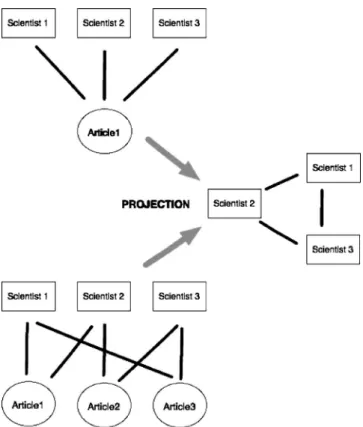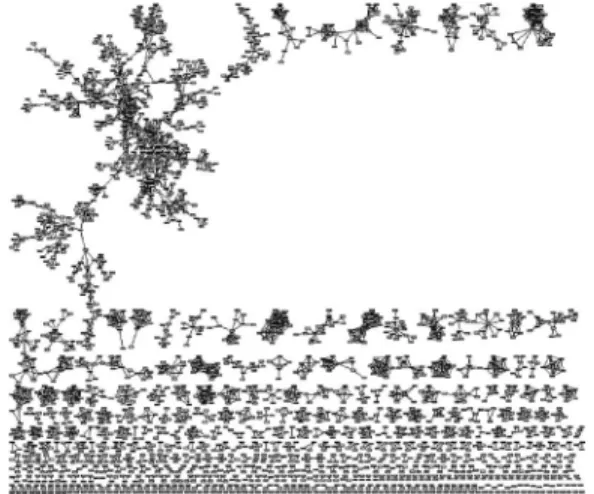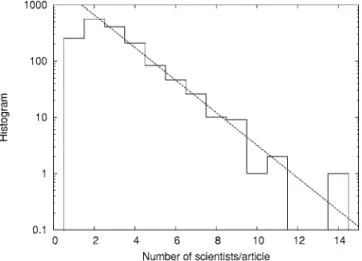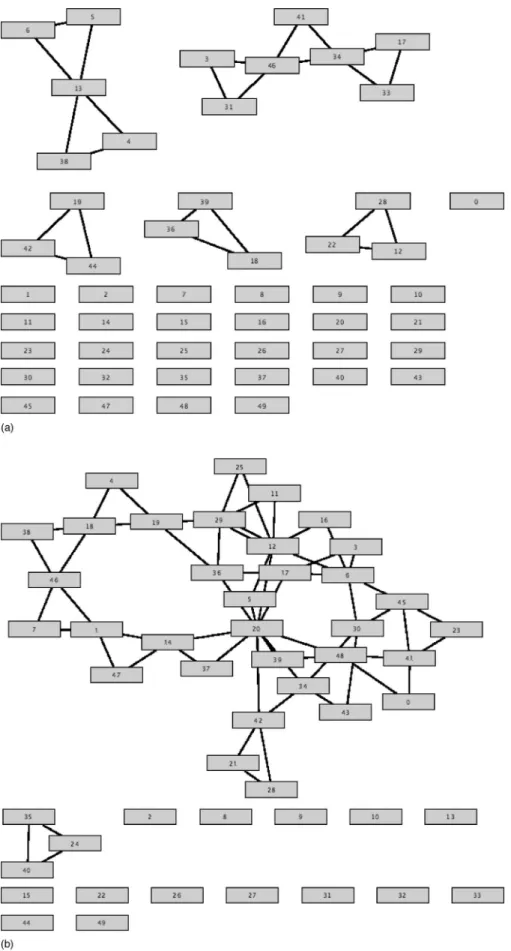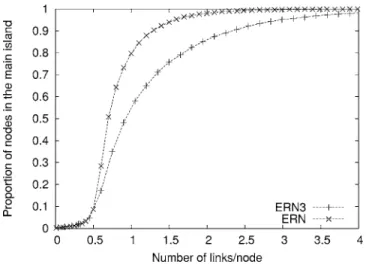RESEARCH OUTPUTS / RÉSULTATS DE RECHERCHE
Author(s) - Auteur(s) :
Publication date - Date de publication :
Permanent link - Permalien :
Rights / License - Licence de droit d’auteur :
Bibliothèque Universitaire Moretus Plantin
Institutional Repository - Research Portal
Dépôt Institutionnel - Portail de la Recherche
researchportal.unamur.be
University of Namur
N -body decomposition of bipartite author networks
Lambiotte, R.; Ausloos, M.
Published in:
Physical Review E - Statistical, Nonlinear, and Soft Matter Physics
DOI:
10.1103/PhysRevE.72.066117 Publication date:
2005
Document Version
Publisher's PDF, also known as Version of record
Link to publication
Citation for pulished version (HARVARD):
Lambiotte, R & Ausloos, M 2005, 'N body decomposition of bipartite author networks', Physical Review E
-Statistical, Nonlinear, and Soft Matter Physics, vol. 72, no. 6. https://doi.org/10.1103/PhysRevE.72.066117
General rights
Copyright and moral rights for the publications made accessible in the public portal are retained by the authors and/or other copyright owners and it is a condition of accessing publications that users recognise and abide by the legal requirements associated with these rights. • Users may download and print one copy of any publication from the public portal for the purpose of private study or research. • You may not further distribute the material or use it for any profit-making activity or commercial gain
• You may freely distribute the URL identifying the publication in the public portal ?
Take down policy
If you believe that this document breaches copyright please contact us providing details, and we will remove access to the work immediately and investigate your claim.
N-body decomposition of bipartite author networks
R. Lambiotte*and M. Ausloos†
SUPRATECS, Université de Liège, B5 Sart-Tilman, B-4000 Liège, Belgium
共Received 20 July 2005; revised manuscript received 6 October 2005; published 15 December 2005兲
In this paper, we present a method to project co-authorship networks, that accounts in detail for the geo-metrical structure of scientists’ collaborations. By restricting the scope to three-body interactions, we focus on the number of triangles in the system, and show the importance of multi-scientist共more than two兲 collabora-tions in the social network. This motivates the introduction of generalized networks, where basic conneccollabora-tions are not binary, but involve arbitrary number of components. We focus on the three-body case and study numerically the percolation transition.
DOI:10.1103/PhysRevE.72.066117 PACS number共s兲: 89.75.Fb, 89.75.Hc, 87.23.Ge
I. INTRODUCTION
It is well known in statistical physics that N-body corre-lations have to be carefully described in order to characterize statistical properties of complex systems. For instance, in the case of the Liouville equation for Hamiltonian dynamics, this problem is at the heart of the derivation of the reduced BBGKY hierarchy, thereby leading to the Boltzmann and Enskog theories for fluids 关1兴. In this line of thought, it is primordial to discriminate N-body correlations that are in-trinsic N-body interactions from those that merely develop from lower order interactions. This issue is directly related to a well-known problem in complex network theory, i.e., the “projection” of bipartite networks, i.e., composed of two kinds of nodes, onto unipartite networks, i.e., composed of one kind of node. As a paradigm for such systems, people
usually consider co-authorship networks关2–4兴, namely
net-works whose nodes are scientists and articles, with links run-ning between scientists and the papers they wrote. In that
case, the usual projection method 关5兴 consists in focusing,
e.g., on the scientist nodes and in drawing a link between
them if they co-authored a common paper共see Fig. 1兲. As a
result, the projected system is a unipartite network of scien-tists that characterizes the community structure of science collaborations. Such studies have been very active recently, due to their complex social structure关6兴, to the ubiquity of such bipartite networks in complex systems关7–9兴, and to the large databases available.
A standard quantity of interest in order to characterize the structure of the projected network is the clustering
coeffi-cient 关10兴, which measures network “transitivity,” namely
the probability that two co-authors of a scientist have them-selves co-authored a paper. In topological terms, it is a mea-sure of the density of triangles in a network, a triangle being formed every time two of one’s collaborators collaborate with each other. This coefficient is usually very high in
sys-tems where sociological cliques develop关11兴. However, part
of the clustering in the co-authorship network is due to pa-pers with three or more co-authors. Such papa-pers introduce
trivial triangles of collaborating authors共see Fig. 1兲, thereby increasing the clustering coefficient. This problem, that was
raised by Newman et al.关5兴, was circumvented by studying
directly the bipartite network, in order to infer the authors’ community structure. Newman et al. showed on some ex-amples that these high-order interactions may account for one half of the clustering coefficient. One should note, how-ever, that if this approach offers a well-defined theoretical framework for bipartite networks, it suffers a lack of trans-parency as compared to the original projection method, i.e., it does not allow a clear visualization of the unipartite struc-ture.
*Electronic address: renaud.lambiotte@ulg.ac.be
†
Electronic address: marcel.ausloos@ulg.ac.be
FIG. 1. Usual projection method of the bipartite graph on a unipartite scientists graph. Nonbijectivivity of the application sim-plifies the structure of the network, thereby hiding, amongst others, the signification of triangles in the unipartite scientists graph.
In this article, we propose an alternative approach that is based on a more refined unipartite projection and follows statistical mechanics usual expansion methods. To do so, we focus on a data set, retrieved from the arXiv database and composed of articles dedicated to complex network theory. This choice is motivated by their relatively few co-authors per article, a property typical to theoretical physics papers 关12兴. Our method consists in discriminating the different kinds of scientist collaborations, based upon the number of co-authors per article. This discrimination leads to a diagram representation关13,14兴 of co-authorship 共see also 关15兴 for the
applicability of Feynman diagrams in complex networks兲.
The resulting N-body projection reconciles the visual fea-tures of the usual projection and the exact description of Newman’s theoretical approach. Empirical results confirm the importance of high-order collaborations in the network structure. Therefore, we introduce in the last section a simple network model, which is based on random triangular connec-tions between the nodes. We study numerically percolation features in the model.
II. N-BODY PROJECTION METHOD
The data set contains all articles from arXiv in the time interval关1995:2005兴 that contain the word “network” in their abstract and are classified as “cond-mat”兲. In order to dis-criminate the authors and avoid spurious data, we checked the names and the first names of the authors. Moreover, in order to avoid multiple ways for an author to co-sign a paper, we also took into account the initial notation of the pre-names. For instance, Marcel Ausloos and M. Ausloos are the same person, while Marcel Ausloos and Mike Ausloos are considered to be different. Let us stress that this method may lead to ambiguities if an initial refers to two different first names, e.g., M. Ausloos might be Marcel Ausloos or Mike
Ausloos. Nonetheless, we have verified that this case occurs
only once in the data set 共Hawoong Jeong, Hyeong-Chai
Jeong, and H. Jeong兲, so that its effects are negligible. In
that sole case, we attributed the papers of H. Jeong to the most prolific Jeong, i.e., Hawoong Jeong in the data set. Given this identification method, we find nP= 2533 persons
and nA= 1611 articles. By using the projection method of Fig.
1, the author network is made of a large connected island composed of 567 scientists and by a multitude of small
dis-connected clusters 共Fig. 2兲. The size s distribution of the
clusters共Fig. 3兲 shows a power law decrease ⬃s−2,
compat-ible with the observations of关16兴. Let us also stress that the distribution of the number of co-authors per article共Fig. 4兲 shows clearly a rapid exponential decrease, associated to a clear predominance of small collaborations.
Formally, the bipartite structure authors-papers may be
mapped exactly on the vector of matricesM defined by
M = 关M共1兲,M共2兲, . . . ,M共j兲,… . ,M共nP兲兴 共1兲
where M共j兲is a square nP j
matrix that accounts for all articles co-authored by j scientists. By definition, the element Ma
1¯aj 共j兲
is equal to the number of articles co-authored by the j au-thors a1, . . . , aj. In the following, we assume that
co-authorship is not a directed relation, thereby neglecting the position of the authors in the collaboration, e.g., whether or not the author is the first author. This implies that the matri-ces are symmetric under permutations of indimatri-ces. Moreover, as people cannot collaborate with themselves, the diagonal elements Maa共j兲¯a vanish by construction. For example, Ma
1 共1兲
and Ma
1a2
共2兲 represent respectively the total number of papers
written by a1 alone, and the total number of papers written
by the pair共a1, a2兲.
A way to visualizeM consists in a network whose nodes
are the scientists and whose links are discriminated by their shape. The intrinsic co-authorship interactions form loops 共order 1兲, lines 共order 2兲, triangles 共order 3兲 共see Fig. 5兲,… . To represent the intensity of the multiplet interaction, the width of the lines is taken to be proportional to the number of collaborations of this multiplet. Altogether, these rules
lead to a graphical representation ofM that is much more
refined than the usual projection method共Fig. 6兲.
It is important to point out that the vector of matricesM describes without approximation the bipartite network, and
FIG. 2. Network of scientists having written a “network” article in the time interval关1995:2005兴 共see text for data acquisition兲. The main island of co-authors is composed by 567 authors and 1325 links.
FIG. 3. Histogram of the size s of the disconnected islands of Fig. 2. The dashed line⬃s−2is a guide for the eye. The extreme
event at s = 567 corresponds to the main island.
R. LAMBIOTTE AND M. AUSLOOS PHYSICAL REVIEW E 72, 066117共2005兲
that it reminds the Liouville distribution in phase space of a Hamiltonian system. Accordingly, a relevant macroscopic description of the system relies on a coarse-grained reduction of its internal variables. The simplest reduced matrix is the
one-scientist matrix R共1兲that is obtained by summing over
the N-body connections, N艌2. R共1兲is a nPvector for which
the element a1is Ra共1兲1 = Ma1共1兲+
兺
a2 Ma共2兲1a2+兺
a2 a3兺
⬍a2 Ma共3兲1a2a3+ ¯ +兺
a2 ¯兺
aj⬍aj−1 Ma1¯aj 共j兲 + ¯ . 共2兲It is straightforward to show that the elements Ra
j
共1兲denote the
total number of articles written by the scientist aj. The
sec-ond order共nP⫻nP兲 matrix is Ra共2兲1a2= Ma共2兲1a2+
兺
a3 Ma1¯a3 共3兲 + ¯ +兺
a3 ¯兺
aj⬍aj−1 Ma共j兲1¯aj+ ¯ . 共3兲Its elements represent the total number of articles written by
the pair of scientists共a1, a2兲. Remarkably, this matrix
repro-duces the usual projection method 共Fig. 1兲 and obviously
simplifies the structure of the bipartite structure by hiding the effect of high-order connections. The three-scientist matrix reads similarly R共3兲a1a2a3= M共3兲a1a2a3+
兺
a4 Ma1¯a4 共4兲 + ¯ +兺
a4 ¯兺
aj⬍aj−1 Ma1¯aj 共j兲 + ¯ . 共4兲This new matrix counts the number of papers co-written by the triplet共a1, a2, a3兲 and may be represented by a network
whose links are triangles relating three authors. The gener-alization to higher order matrices R共j兲is straightforward, but, as in the case of the BBGKY hierarchy, a truncature of the
vector M must be fixed at some level in order to usefully
and compactly describe the system. It is therefore important to point out that the knowledge of M共2兲together with R共3兲is completely sufficient in order to characterize the triangular
structure of M. Consequently, in this paper, we stop the
reduction procedure at the three-body level and define the triangular projection ofM by the application
关M共1兲a1, Ma共2兲1a2, M共3兲a1a2a3,…,Ma1. . .anP 共nP兲 兴 → 关M a1 共1兲, M a1a2 共2兲 ,R a1a2a3 共3兲 兴. 共5兲 The triangular projection is depicted in Fig. 7 and is com-pared to the usual projection method.
In order to test the relevance of this description, we have measured in the data set the total number of triangles
FIG. 4. Histogram of the number of scientists/articles, n, for the same data as in Fig. 2. The dashed line corresponds to the fit e−n/1.5.
FIG. 5. Graphical representation of the four most basic authors’ interactions, namely, 1, 2, 3, 4 co-authorships.
FIG. 6. Graphical representation of the co-authorship network. This small subnetwork accounts for one two-author collaboration 共Timme, Ashwin兲; four three-author collaborations, three times the triplet 共Timme, Wolf, Geisel兲 depicted by stronger links and once 共Geisel, Hufnagel, Brockmann兲; one four-author collaboration 共Timme, Wolf, Geisel, Zumdieck兲.
generated by edges. We discriminate two kinds of triangles:
those which arise from one three-body interaction of R共3兲
and those which arise only from an interplay of different interactions. There are respectively 5550 and 30 such tri-angles, namely 99.5% of triangles are of the first kind. This observation by itself therefore justifies the detailed projection method introduced in this section and shows the importance of co-authorship links geometry in the characterization of network structures, precisely the clustering coefficient in the present case.
III. TRIANGULAR ERDÖS-RÉNYI NETWORKS
The empirical results of the previous section have shown the significance of N-body connections in social networks. A more complete framework for networks is therefore required in order to describe correctly the system complexity. In this article, we focus on the most simple generalization, namely a network whose links relate triplets of nodes. To do so, we base our modeling on the Erdös-Rényi uncorrelated random
graph 关17兴, i.e., the usual prototype to be compared with
more complex random graphs. The usual Erdös-Rényi
net-FIG. 7. Three-body projection of the bipartite network. For the sake of clarity, we focus on a small subcluster, centered around the collaborations of Newman. The upper figure is the usual projection method of Fig. 1. The lower figure is the triangular projection共4兲 of the same bipartite network.
R. LAMBIOTTE AND M. AUSLOOS PHYSICAL REVIEW E 72, 066117共2005兲
work共ERN兲 is composed by Nnlabeled nodes connected by
Ne共2兲 edges, which are chosen randomly from the
Nn共Nn− 1兲/2 possible edges. In this paper, we define the
tri-angular ER network共ERN共3兲兲 to be composed by Nn labeled
nodes, connected by Ne共3兲 triangles, which are chosen ran-domly from the Nn共Nn− 1兲共Nn− 2兲/6 possible triangles. As a
result, connections in the system relate triplets of nodes 共a1, a2, a3兲, and the matrix vector M reduces to the matrix
M共3兲. Before going further, let us point out that the clustering coefficient of triangular ER networks is very high by con-struction, but, contrary to intuition, it is different from 1 in general. For instance, for the two triplets 共a1, a2, a3兲 and
共a1, a4, a5兲, the local clustering coefficient of a1is equal to 1 3.
In this paper, we focus numerically on the percolation
transition关18兴 in ERN共3兲, i.e., on the appearance of a giant component by increasing the number of links in the system 共Fig. 8兲. This transition is usually associated with dramatic changes in the topological structure, which are crucial to ensure communicability between network nodes, e.g., the spreading of scientific knowledge in the case under study. In the following, we work at a fixed number of nodes and focus on the proportion of nodes in the main cluster as a function of the number of binary links in the system. Moreover, in order to compare results with the usual ERN, we do not count twice redundant links, i.e., couples of authors who interact in different triplets. For instance, the triplet 共a1, a2, a3兲 accounts for three binary links, but 共a1, a2, a3兲
and 共a1, a2, a4兲 account together for five links, so that
FIG. 8. Percolation transition in a triangular Erdös-Rényi network共see text for definition兲 made of 50 nodes, from a dilute phase with small disconnected islands共8 triangles兲 to a percolated phase with one giant cluster 共20 triangles兲.
R. LAMBIOTTE AND M. AUSLOOS PHYSICAL REVIEW E 72, 066117共2005兲
Ne共2兲⫽3Ne共3兲 in general. Let us note, however, that this de-tailed counting has small effects on the location of the per-colation transition. Numerical results are depicted in Fig. 9,
where we consider networks with Nn= 1000 and where 50
realizations of the simulations have been performed for each
value of the number of links/node in order to improve the statistics. Obviously, the triangular structure of interactions displaces the bifurcation point, by requiring more links in order to observe the percolation transition. This feature comes from the triangular structure of connections that re-strains the network exploration as compared to random struc-tures. Indeed, three links relate only three nodes in ERN共3兲, while three links relate at least three nodes in ERN共Fig. 10兲. Finally, let us stress that the same mechanism takes place in systems with high clustering coefficients关19,20兴.
IV. CONCLUSION
In this paper, we show the importance of N-body interac-tions in co-authorship networks. By focusing on data sets extracted from the arXiv database, we introduce a way to project bipartite networks onto unipartite networks. This ap-proach generalizes usual projection methods by accounting for the complex geometrical figures connecting authors. To do so, we present a simple theoretical framework and define
N-body reduced and projected networks. The graphical
rep-resentation of these simplified networks rests on a “shape-based” discrimination of the different co-authorship
interac-tions 共for a “color-based” version, see the first author’s
website关21兴兲 and allows a clear visualization of the different
FIG. 9. Proportion of nodes in the main island, as a function of the number of links/node, in the ERN and the ERN共3兲model. The networks are composed of 1000 nodes.
FIG. 10. Different ways to distribute three links in a network, thereby connecting from three to six nodes. Obviously, only the first case共three nodes兲 occurs in a triangular Erdös-Rényi network.
mechanisms occurring in the system. Finally, we apply the method to some arXiv data subset, thereby showing the im-portance of such “high-order corrections” in order to charac-terize the community structure of scientists. The empirical results motivate therefore a better study of networks with complex weighted geometrical links. In the last section, we focus on the simplest case by introducing a triangular ran-dom model, ERN共3兲, and restrict the scope by analyzing the effect of the three-body connection on percolation. A com-plete study of the topological of ERN共3兲as well as its
gener-alization to higher order connections is left for a forthcoming work.
ACKNOWLEDGMENTS
Figures 2 and 5–8 were plotted thanks to the visone
graphical tools关22兴. R.L. is supported by European
Commis-sion Project CREEN FP6-2003-NEST-Path-012864. We also thank the COST P10 Physics of Risk European Project.
关1兴 P. Résibois and M. De Leener, Classical Kinetic Theory of
Fluids共Wiley, New York, 1977兲.
关2兴 M. E. J. Newman, Proc. Natl. Acad. Sci. U.S.A. 98, 404 共2001兲.
关3兴 A. L. Barabási, H. Jeong, Z. Néda, E. Ravasz, A. Schubert, and T. Vicsek, Physica A 31, 590共2002兲.
关4兴 R. Lambiotte and M. Ausloos, e-print physics/0508234. 关5兴 M. E. J. Newman, S. H. Strogatz, and D. J. Watts, Phys. Rev.
E 64, 026118共2001兲.
关6兴 M. E. J. Newman, D. J. Watts, and S. H. Strogatz, Proc. Natl. Acad. Sci. U.S.A. 99, 2566共2002兲.
关7兴 A. L. Barabási, H. Jeong, Z. Neda, E. Ravasz, A. Schubert, and T. Vicsek, Physica A 311, 590共2002兲.
关8兴 J. J. Ramasco, S. N. Dorogovtsev, and R. Pastor-Satorras, Phys. Rev. E 70, 036106共2004兲.
关9兴 R. Lambiotte and M. Ausloos, e-print physics/0508233. 关10兴 D. J. Watts and S. H. Strogatz, Nature 共London兲 393, 440
共1998兲.
关11兴 D. Fenn, O. Suleman, J. Efstathiou, and N. F. Johnson, e-print physics/0505071.
关12兴 J. W. Grossman, Congr. Numer. 158, 202 共2002兲.
关13兴 R. D. Mattuck, A Guide to Feynman Diagrams in the
Many-Body Problem共Dover, New York, 1992兲.
关14兴 J. E. Mayer and M. G. Mayer, Statistical Mechanics 共Wiley, New York, 1940兲.
关15兴 J. Berg and M. Lässig, Phys. Rev. Lett. 89, 228701 共2002兲. 关16兴 F. Pütsch, Adv. Complex Syst. 6, 1 共2003兲.
关17兴 P. Erdös and A. Rényi, Publ. Math. Inst. Hung. Acad. Sci. 5, 17共1960兲.
关18兴 I. Derenyi, G. Palla, and T. Vicsek, Phys. Rev. Lett. 94, 160202共2005兲.
关19兴 M. E. J. Newman, Phys. Rev. E 68, 026121 共2003兲. 关20兴 R. Lambiotte and M. Ausloos, e-print physics/0508233. 关21兴 http://www.lambiotte.be/parallel/nBody/nBody.html 关22兴 http://www.visone.de/
R. LAMBIOTTE AND M. AUSLOOS PHYSICAL REVIEW E 72, 066117共2005兲
